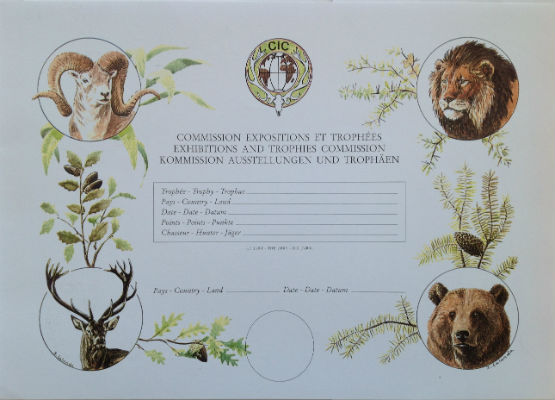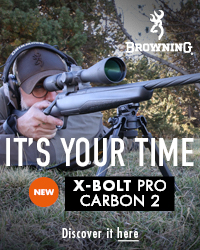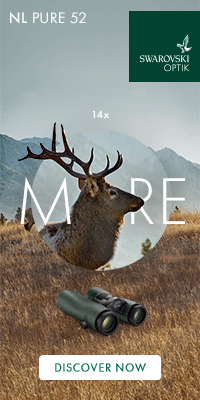Iain Watson Senior International Trophy Judge looks at the CIC Trophy Evaluation System, and offers some tips to those lucky enough to grass a trophy animal this season.
Below: "The quality of British roe, the largest trophy judged in 2012 with a score of more than 220 CIC points"
 Since its inception in the late 1920's the CIC measurement system has become recognised throughout the Continent, and further afield, as representing the benchmark of European trophy evaluation. The status of its medals and certificates are recognised by stalkers and hunters worldwide. Currently, from its headquarters in Budapest, the organisation has a presence in more than 80 countries, its global community advocating sustainable hunting to benefit people, and conserve nature.
Since its inception in the late 1920's the CIC measurement system has become recognised throughout the Continent, and further afield, as representing the benchmark of European trophy evaluation. The status of its medals and certificates are recognised by stalkers and hunters worldwide. Currently, from its headquarters in Budapest, the organisation has a presence in more than 80 countries, its global community advocating sustainable hunting to benefit people, and conserve nature.
Over the past 50 years a database of British trophies has been maintained, and 16 years ago the national delegation of the CIC established a Permanent National Trophy Commission. Accredited judges were then appointed to formally evaluate trophies, using the CIC system, record them and issue internationally recognised awards.
Since the early 1960's the CIC system has been instrumental in bringing to the attention of the stalking community the huge improvement in the quality of our wild deer, and in particular gaining international recognition for the pre-eminence of British roe bucks. Such has been the improvement in roe, that we now challenge the very best that Central Europe can offer, and as recently as last season two Scottish trophies exceeded 210 CIC points.
As far as European deer species are concerned, the CIC system is unique in that not only does it include a weight element for red, roe, and fallow trophies, but it also awards points for 'beauty', and deducts points for trophies of inferior quality, or irregular formation. In recent years the system has also had to be responsive to changes in deer populations and stalking fashions. The latter has seen the increasing importance of both muntjac and Chinese water deer as trophy species, as well as the establishment of wild boar as a British quarry animal.
The CIC advocates a fair chase policy, and requires stalkers to sign a declaration that any trophy submitted has been obtained in a fair manner from an established free living population. Only after this declaration has been made will the trophy be entered to the records. We do not issue medals to animals which have come from farmed or in park situations, nor will we consider any domestic animals.
The current UK Commission consists of eight accredited CIC judges supported by three technical advisors. Two of the judges were recently appointed by the CIC executive committee as Senior International Trophy Judges, and now sit on the policy-making International Trophy Evaluation Board. The UK team evaluate around 1,000 trophies per year. The majority come from our six established deer species, as well as feral goats and wild boar.

"The iconic CIC medal in this case a silver"
It would be no exaggeration to acknowledge that the current group are one of the most experienced of all the European teams, particularly in relation to roe. To ensure consistency, ongoing training sessions are held and judges regularly work with each other in different parts of the country. The team are trained in all European species with members also working with Asian and African animals. As well as their CIC status, team members are also appointed as Rowland Ward measurers, thereby maintaining a link with British trophy measuring dating back to 1892.

"International certificate of measurement issued to qualifying trophies"
Getting the most from your trophy.
For many stalkers a CIC medal trophy can be a once in a lifetime event,and deserves to be treated as such.
In three of our UK species, red, roe, and fallow, the weight element can be critical in achieving the maximum score for the trophy. A further requirement is that these trophies are allowed to dry for 90 days prior to being submitted for scoring, to ensure that all retained moisture is eliminated. The CIC will not measure trophies which have not been dried for the required time. Nor will it issue estimates, the so-called Provisional Scores. No such measurement exists within the rules, therefore such estimates can have no validity.
 Many stalkers make the mistake of cutting the skull of the trophy prior to having it judged, and this can often lead to disappointment when it arrives on the judges' bench. This is particularly true of roe trophies. When a roe trophy is presented with a full upper skull the maximum which will be deducted is 90 grams. Experience has shown that the often favoured "standard" long nose cut will often be at a disadvantage, and a deduction will be made for the remaining skull resulting in a lower final score than would have been achieved had the skull been left uncut.The advice therefore is always to present the trophy with a full skull. If you want to cut it to display the trophy please wait until the score has been awarded and the certificate issued.
Many stalkers make the mistake of cutting the skull of the trophy prior to having it judged, and this can often lead to disappointment when it arrives on the judges' bench. This is particularly true of roe trophies. When a roe trophy is presented with a full upper skull the maximum which will be deducted is 90 grams. Experience has shown that the often favoured "standard" long nose cut will often be at a disadvantage, and a deduction will be made for the remaining skull resulting in a lower final score than would have been achieved had the skull been left uncut.The advice therefore is always to present the trophy with a full skull. If you want to cut it to display the trophy please wait until the score has been awarded and the certificate issued.
This summer the measuring team will be present at the CLA Game Fair, as well as the Midland. In Scotland we will be at Scone, and at the Highland Field Sports Fair.
Above: "The CIC Red Book contains all of the current formulae for measurement".
For more on How to Measure a Trophy Follow this link: how-to-measure-a-trophy
Alternatively to read about when to shoot your Trophy Roe Buck take a look at this article, also by Iain Watson: when-to-shoot-that-trophy
Iain Watson is a CIC Senior International Trophy Judge and Expert to the UK Delegation of the CIC. He has been involved in trophy measuring since the mid-1980's . He can be contacted for advice on trophies by email at



















